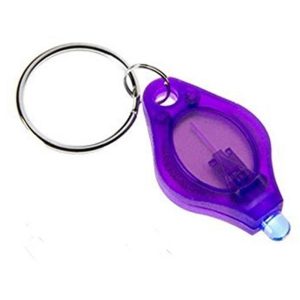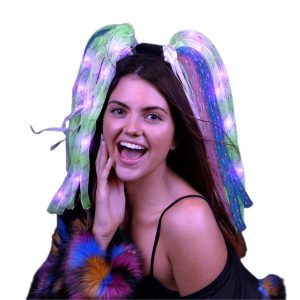How to Use UV Lights to Detect Hidden Messages and Markings
UV (ultraviolet) light is a powerful tool often associated with forensic investigations, currency verification, and hidden artwork, but it also has many creative and practical uses beyond these domains. Using UV lights, you can reveal hidden messages, markings, and patterns that are invisible to the naked eye. Whether you are an investigator, educator, hobbyist, or just a curious individual, learning how to effectively use UV light opens up a fascinating world of mystery and discovery.
In this blog, we’ll take an in-depth look at how UV light works, the types of hidden content you can uncover, and how to use UV lights safely and effectively. We’ll also explore the science behind UV detection and provide real-world applications where UV light plays a critical role. Finally, we’ll offer practical tips and techniques to make your UV exploration a success.
![Led Flashing Noodle Dreads Headband Neon Second Model[1]](https://blinkee.com/blinkeeblog/wp-content/uploads/2024/10/LED-Flashing-Noodle-Dreads-Headband-Neon-Second-Model1.jpeg)
I. Understanding UV Light: How It Reveals the Invisible
UV light, also known as black light, belongs to the ultraviolet spectrum, which is just beyond the range of human vision. While visible light falls between 380 and 700 nanometers, UV light has a shorter wavelength, typically 100 to 400 nanometers. When certain substances are exposed to UV light, they fluoresce—that is, they absorb the UV energy and re-emit it as visible light.
This unique reaction allows UV lights to uncover hidden information in objects that appear normal under regular lighting. Substances such as inks, dyes, minerals, and organic compounds often glow under UV light, revealing messages or patterns that are otherwise unseen.
II. Types of Hidden Content Revealed by UV Lights
UV lights are versatile tools that can be used to reveal a wide variety of hidden markings, substances, and messages. Below are some of the most common types of content detectable with UV light:
1. Invisible Ink and Secret Messages
- Invisible inks are specially designed to remain invisible under normal light and only appear when illuminated with UV light.
- These inks are popular in spies’ tools, escape rooms, and children’s activities, offering an exciting way to hide and reveal information.
2. Security Markings on Currency and Documents
- Many forms of currency (such as the U.S. dollar, Euro, and British pound) contain UV-reactive threads or markings as anti-counterfeiting measures.
- Important documents like passports, government IDs, and credit cards also contain UV-visible patterns for authenticity verification.
3. Forensic Evidence and Fingerprints
- In criminal investigations, forensic experts use UV lights to reveal bodily fluids, fibers, and fingerprints that are not visible under normal light.
- Certain chemicals used in crime scenes—such as luminol—glow under UV exposure, aiding investigators in gathering critical evidence.
4. Artwork, Paintings, and Restoration Work
- UV light helps art historians and restorers detect overpainting, hidden signatures, and previous repairs in historical artworks.
- Some artists use fluorescent pigments to embed hidden elements into their paintings, which become visible only under UV light.
5. Product Authentication and Anti-Counterfeiting Measures
- High-value items such as luxury goods, electronics, and pharmaceuticals are often marked with UV-reactive labels or codes to verify authenticity.
- Manufacturers use UV-based technology to prevent counterfeit goods from entering the market.
6. Biological Traces and Contaminants
- In fields like biology and medicine, UV light can detect mold, bacteria, and other organic matter.
- Pest control specialists use UV lights to find trails left by insects, like scorpions or bedbugs, which fluoresce under UV light.
III. Tools You Need for UV Detection
To get started with UV detection, you’ll need a few essential tools. Here’s a list of everything you might require:
1. UV Light Source (Black Light)
UV lights are available in different forms, such as handheld flashlights, tube lights, and keychain UV LEDs. Select the one that best fits your purpose.
- 365nm UV light: Ideal for forensic work and detecting high-quality UV-reactive materials.
- 395nm UV light: Common in general-purpose UV flashlights and inexpensive tools.
2. UV-Reacting Inks or Markers
If you’re working with invisible ink messages, purchase UV-reactive pens or markers. These are often used in escape rooms, puzzles, and DIY projects.
3. Protective Gear
Long exposure to UV light can be harmful to your eyes and skin. It’s essential to wear UV-protective goggles and gloves when working with UV lights for extended periods.
4. Dark Environment
For best results, perform UV detection in a dark room or area to maximize the visibility of fluorescent substances.
IV. Step-by-Step Guide: How to Detect Hidden Messages with UV Lights
Step 1: Set Up Your UV Light Source
- Choose a suitable UV light, ensuring it emits the correct wavelength for your task.
- Test the UV light in a dimly lit room to check its functionality.
Step 2: Identify the Target Object or Surface
- If you’re inspecting currency or a document, place it flat on a surface.
- For invisible ink messages, you can either write one yourself using a UV pen or look for pre-existing markings on surfaces or objects.
Step 3: Illuminate the Area with UV Light
- Shine the UV light directly onto the object or surface you want to examine. Move the light slowly across the surface, looking for any fluorescent reactions.
Step 4: Observe for Fluorescence
- If any hidden markings, fingerprints, or substances are present, they will glow under the UV light.
- Take note of patterns, text, or symbols that appear and try to document or photograph them for reference.
Step 5: Analyze Your Findings
- Depending on the context (forensics, art restoration, or product authentication), you may need to compare your findings with known references or patterns.
V. Applications of UV Light Detection in Real Life
1. Forensics and Law Enforcement
Police and crime scene investigators use UV lights to detect bloodstains, bodily fluids, and trace evidence. This non-invasive technique helps gather critical evidence without altering the scene.
2. Currency Verification and Fraud Prevention
Banks and retailers use UV lights to quickly verify the authenticity of bills and credit cards, preventing counterfeit currency from entering circulation.
3. Art Restoration and Authentication
Art collectors and museums use UV light to check for hidden signatures, repairs, or forgery in valuable paintings.
4. Science and Education
In educational settings, teachers use UV lights to demonstrate chemical reactions, fluorescence, and biological processes to students.
5. DIY Fun and Escape Rooms
Invisible ink messages that only appear under UV light are a staple in escape rooms and treasure hunts, adding an element of mystery and excitement.
VI. Tips and Best Practices for UV Detection
- Use fresh batteries for handheld UV lights to ensure optimal brightness and performance.
- If working with artifacts or paintings, avoid prolonged exposure to UV light, as it can degrade certain materials.
- Combine UV detection with other tools, such as magnifying glasses, for detailed examination.
- Document your findings with photos, especially when working on forensic investigations or product authentication.
- Always turn off the UV light when not in use to avoid unnecessary exposure and conserve battery life.
VII. The Science Behind Fluorescence and UV Detection
Fluorescence occurs when a material absorbs UV light and re-emits it at a visible wavelength. This phenomenon is possible due to excited electrons inside the material, which absorb the UV energy and jump to higher energy levels. When they return to their normal state, they release the extra energy as visible light, creating the glowing effect you see under UV exposure.
VIII. Conclusion: A World of Discovery with UV Lights
Using UV lights to detect hidden messages and markings unlocks a realm of invisible secrets. From forensics to fun activities like escape rooms, UV light plays a critical role in unveiling what lies beneath the surface. Whether you’re checking the authenticity of currency, restoring a piece of art, or simply experimenting with invisible ink, UV light detection is a valuable tool that combines science, curiosity, and practicality.
With the right tools, techniques, and safety precautions, anyone can explore the wonders of UV detection. The next time you have a UV flashlight in hand, take a closer look at the world around you—you never know what hidden secrets might be waiting to be discovered!



